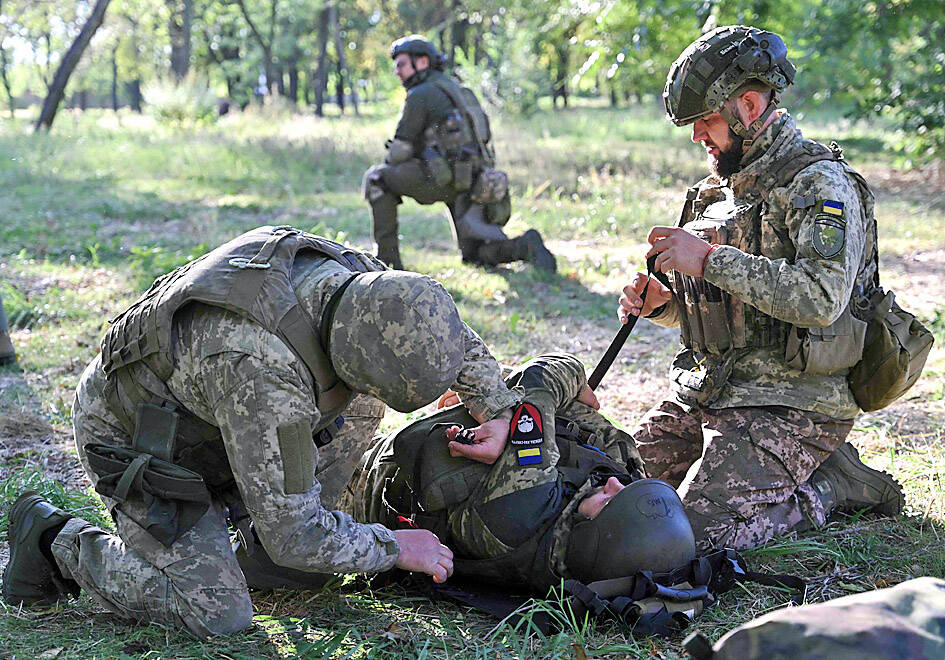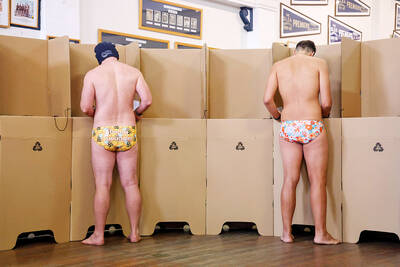For soldiers fighting on Ukraine’s front lines, a split-second first aid decision can be the difference between life or death.
Whether learning to apply a tourniquet, wrap a bandage or carry a wounded person, regular basic medical training is an essential part of their skill set in the field.
“It’s crucial training, because every soldier needs to know how to save his own life and that of others nearby,” said Victor Pylypenko, a 36-year-old medic in the 72nd Mechanized Brigade.

Photo: AFP
Analysts say that at least tens of thousands of soldiers have been wounded and killed on both sides since Russia’s invasion on Ukraine on Feb. 24 last year, although neither Kyiv nor Moscow have disclosed their losses.
Near the town of Kurakhove, 15km from the eastern front, about 15 soldiers from Pylypenko’s unit gathered for a course delivered by intensive care nurse Mossy, an Australian volunteer.
Starting inside, and then moving to work in the undergrowth, the soldiers practiced applying tourniquets to an arm or leg to stop massive external bleeding, which can lead to death in a matter of minutes. Every soldier is equipped with an individual first aid kit (IFAK), which includes one or two tourniquet straps.
Measuring about 70cm and fitted with a twisting handle, the straps grip the limb above the wound to stop the bleeding.
“The most common wounds in the field are [shrapnel] wounds in the limbs,” Pylypenko said.
The chest and back are also often hit, because “the bullet-proof vest doesn’t fully protect you,” he added.
“There are frequent cases of massive haemorrhaging, and tourniquets have really saved hundreds, if not thousands, of lives,” said Pylypenko, adding that it is “essential” soldiers know how to use them correctly.
The way they are applied and the quality of the tourniquet determines their effectiveness.
“The government provides us with IFAKs, but they are not always good quality,” said Pylypenko, lamenting “fake tourniquets that are deadly on the battlefield.”
Ukrainian non-governmental organizations and combat unit nurses this summer criticized the lack of standardization and poor quality of first aid equipment provided by the government.
Faced with a backlash and after 19 months of war, the Ukranian Ministry of Defense has only recently announced the creation of a medical department within its ranks.
“We are working with our Western partners on the possibility of a rapid decision to confirm the quality of tourniquets produced in Ukraine,” Ukranian Deputy Minister of Defense Natalia Kalmykova said in a TV interview.
During the training course, Mossy advised soldiers to check the origin of their equipment, saying that he had seen “very poor quality” tourniquets coming from China.
“I can’t read the language on some” first aid items, he said, using Pylypenko as a translator to communicate with the soldiers.
“Sometimes when we ask the guys to show this part, they point to something else,” he said.
Although most of the soldiers had already undergone first aid training and applied it in combat, trainers say it is essential to practice and repeat the gestures regularly.
To illustrate his point, Mossy told the story of some soldiers who had placed a tourniquet on a wounded man, which then loosened in transit.
“They didn’t think to check the tourniquet while they were transporting him. It came off and their friend died on the stretcher,” he said. “You have to continually revise [knowledge]. It comes with training and experience, but unfortunately, these lessons are learned in blood.”
Vasyl, a 52-year-old sergeant, listened keenly to the medical training.
He had been wounded three times since the start of the war, including his right eye, which appeared a little sunken.
He said that basic medical knowledge “enabled me to survive three times.”

Kehinde Sanni spends his days smoothing out dents and repainting scratched bumpers in a modest autobody shop in Lagos. He has never left Nigeria, yet he speaks glowingly of Burkina Faso military leader Ibrahim Traore. “Nigeria needs someone like Ibrahim Traore of Burkina Faso. He is doing well for his country,” Sanni said. His admiration is shaped by a steady stream of viral videos, memes and social media posts — many misleading or outright false — portraying Traore as a fearless reformer who defied Western powers and reclaimed his country’s dignity. The Burkinabe strongman swept into power following a coup in September 2022

‘FRAGMENTING’: British politics have for a long time been dominated by the Labor Party and the Tories, but polls suggest that Reform now poses a significant challenge Hard-right upstarts Reform UK snatched a parliamentary seat from British Prime Minister Keir Starmer’s Labor Party yesterday in local elections that dealt a blow to the UK’s two establishment parties. Reform, led by anti-immigrant firebrand Nigel Farage, won the by-election in Runcorn and Helsby in northwest England by just six votes, as it picked up gains in other localities, including one mayoralty. The group’s strong showing continues momentum it built up at last year’s general election and appears to confirm a trend that the UK is entering an era of multi-party politics. “For the movement, for the party it’s a very, very big

ENTERTAINMENT: Rio officials have a history of organizing massive concerts on Copacabana Beach, with Madonna’s show drawing about 1.6 million fans last year Lady Gaga on Saturday night gave a free concert in front of 2 million fans who poured onto Copacabana Beach in Rio de Janeiro for the biggest show of her career. “Tonight, we’re making history... Thank you for making history with me,” Lady Gaga told a screaming crowd. The Mother Monster, as she is known, started the show at about 10:10pm local time with her 2011 song Bloody Mary. Cries of joy rose from the tightly packed fans who sang and danced shoulder-to-shoulder on the vast stretch of sand. Concert organizers said 2.1 million people attended the show. Lady Gaga

SUPPORT: The Australian prime minister promised to back Kyiv against Russia’s invasion, saying: ‘That’s my government’s position. It was yesterday. It still is’ Left-leaning Australian Prime Minister Anthony Albanese yesterday basked in his landslide election win, promising a “disciplined, orderly” government to confront cost-of-living pain and tariff turmoil. People clapped as the 62-year-old and his fiancee, Jodie Haydon, who visited his old inner Sydney haunt, Cafe Italia, surrounded by a crowd of jostling photographers and journalists. Albanese’s Labor Party is on course to win at least 83 seats in the 150-member parliament, partial results showed. Opposition leader Peter Dutton’s conservative Liberal-National coalition had just 38 seats, and other parties 12. Another 17 seats were still in doubt. “We will be a disciplined, orderly